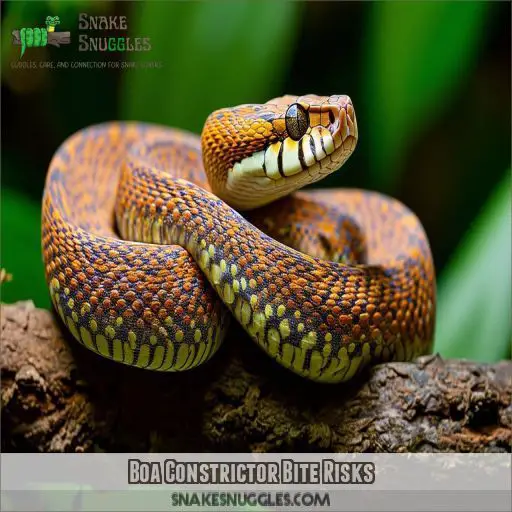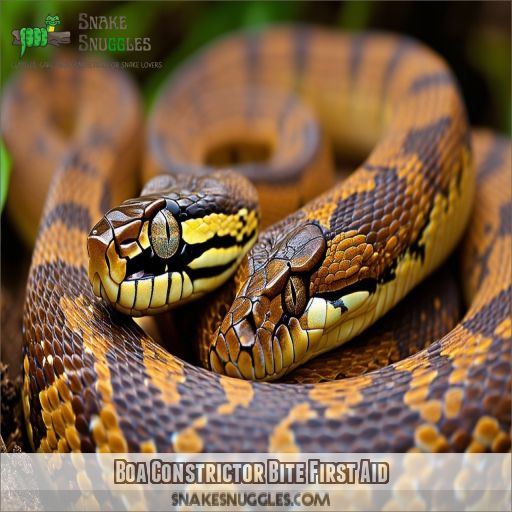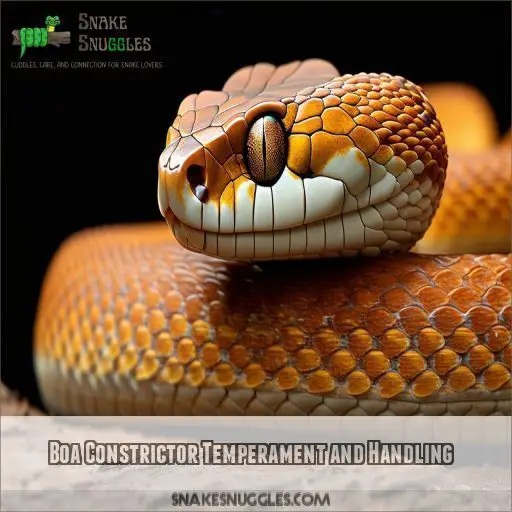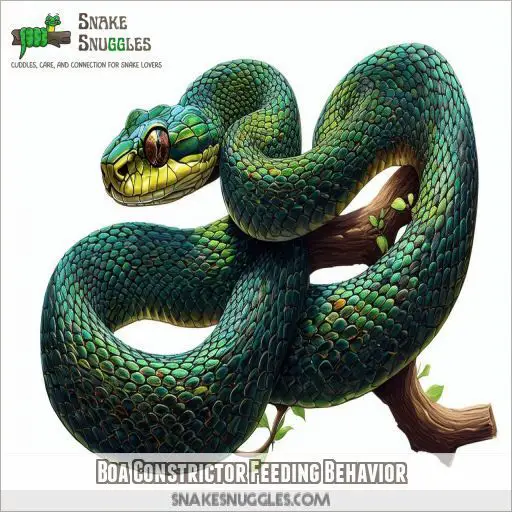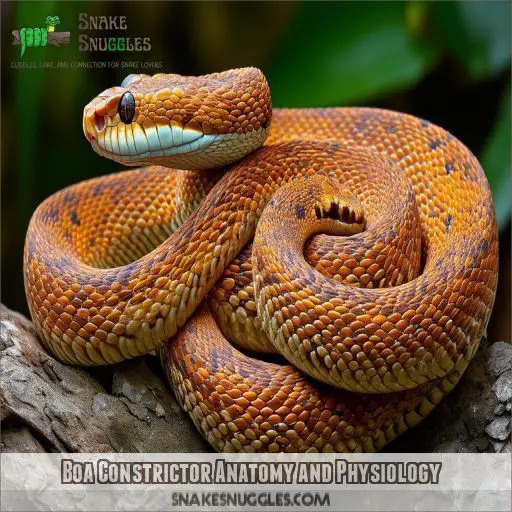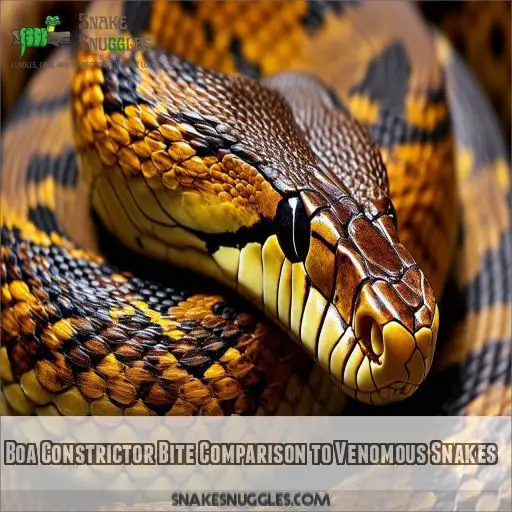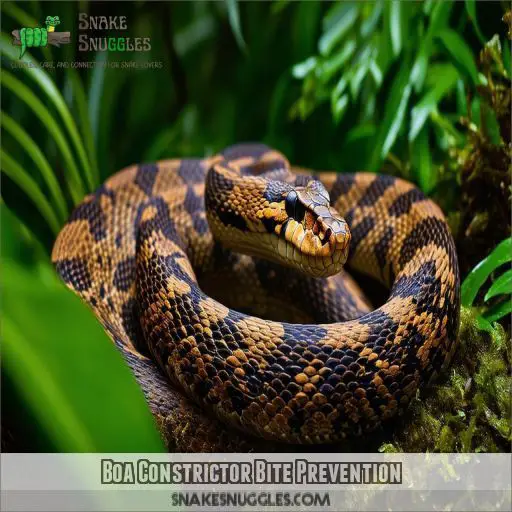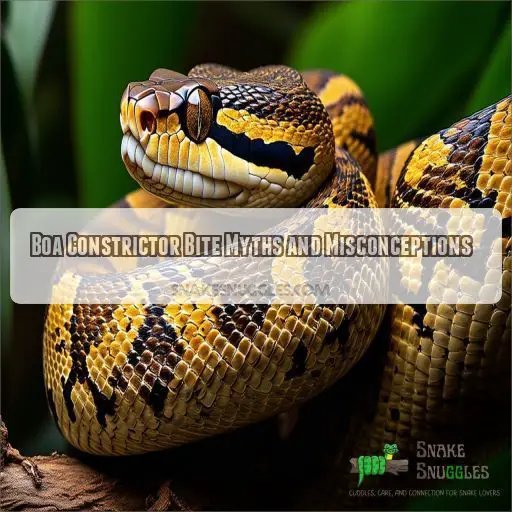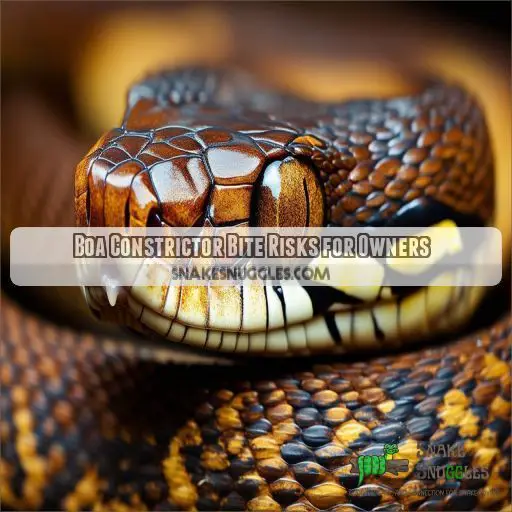This site is supported by our readers. We may earn a commission, at no cost to you, if you purchase through links.
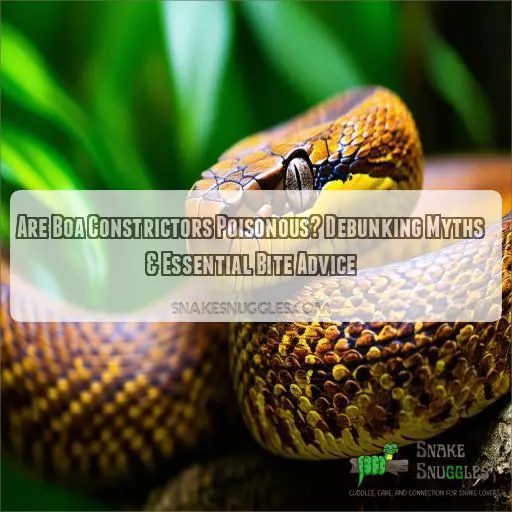 No, boa constrictors aren’t poisonous. These impressive snakes don’t have venom glands or fangs like some of their snake cousins. Instead, they rely on their powerful muscles to squeeze their prey, causing suffocation or circulatory arrest.
No, boa constrictors aren’t poisonous. These impressive snakes don’t have venom glands or fangs like some of their snake cousins. Instead, they rely on their powerful muscles to squeeze their prey, causing suffocation or circulatory arrest.
While their bites can be painful due to sharp teeth and strong jaws, there’s no venom to worry about. If you handle a boa properly and follow basic safety measures, bites are rare.
Want to understand more about safely handling and caring for these fascinating reptiles? Keep going, and you’ll find all the essential details.
Table Of Contents
- Key Takeaways
- Are Boa Constrictors Poisonous?
- Boa Constrictor Venom and Toxicity
- Boa Constrictor Bite Risks
- Boa Constrictor Bite First Aid
- Boa Constrictor Temperament and Handling
- Boa Constrictor Feeding Behavior
- Boa Constrictor Anatomy and Physiology
- Boa Constrictor Bite Comparison to Venomous Snakes
- Boa Constrictor Bite Prevention
- Boa Constrictor Bite Myths and Misconceptions
- Boa Constrictor Bite Risks for Owners
- Frequently Asked Questions (FAQs)
- What happens if a boa constrictor bites you?
- Are boa constrictors friendly pets?
- Is it safe to hold a boa constrictor?
- Are boas aggressive snakes?
- How do boa constrictors kill their prey?
- Are Boa constrictor venomous?
- Are boa constrictors a snake?
- Are boa constrictors a threat to other animals?
- Do boa constrictors bite?
- Can a boa constructor kill a human?
- What is the average lifespan of a boa constrictor?
- How large should a boa constrictor’s enclosure be?
- How often should an adult boa constrictor eat?
- What are signs of Respiratory infection in boas?
- How can you tell if a boa is healthy?
- Conclusion
Key Takeaways
- Boa constrictors aren’t venomous, so no need to be scared, they won’t inject you with any nasty toxins! They’re more like gentle giants, using their impressive muscles to give their prey a big, suffocating hug.
- While their bites aren’t poisonous, they can still pack a punch! Their sharp teeth and strong jaws can leave you with some ouchies, so it’s best to handle them with care and respect their personal space.
- If you do get a little love nip from a boa, don’t panic! Just give the wound a good clean with soap and water, and apply some antiseptic cream to keep it happy and healthy.
- Remember, these magnificent creatures aren’t out to get you. They’re just trying to live their best life, constricting their prey and chilling in their jungle homes. So, let’s give them the respect they deserve!
Are Boa Constrictors Poisonous?
No, boa constrictors aren’t poisonous. They kill their prey by constriction, not venom.
Boa Constrictor Venom and Toxicity
Boa constrictors, unlike some of their snake relatives, don’t possess venom glands or fangs, so they can’t inject venom into their prey or humans . Instead, they rely on their muscular bodies for predation, wrapping around their prey and applying pressure until it suffocates or experiences circulatory arrest. This method makes boa constrictors non-venomous, meaning their bites don’t involve the injection of any toxic substances (Source).
However, a boa constrictor bite can still be quite painful due to their strong jaws and numerous small teeth designed to grip and secure their prey (Source). Understanding this difference is essential for those handling boa constrictors, as knowing they’re non-venomous shouldn’t lead to underestimating their potential to cause injury if threatened or mishandled (Source).
Boa Constrictor Bite Risks
Boa constrictor bites pose risks that you should be aware of, particularly if you own or handle these magnificent reptiles. While they’re non-venomous, their bites can cause significant injuries.
- Bruising and Lacerations: A boa constrictor bite often results in bruising and lacerations due to their sharp teeth. Large boas, like the Boa constrictor constrictor and Boa constrictor imperator, can leave deeper wounds.
- Bleeding: Initial bleeding is common as their teeth puncture the skin.
- Scarring: Some bites, especially from larger boas, may leave permanent scars.
- Mental Stress: The suddenness of a bite can cause shock or nervousness, particularly in novice handlers.
To minimize these risks, practice proper handling techniques. Always approach them calmly and confidently, supporting their bodies and avoiding sudden movements. Knowledge and preparation are your best allies in avoiding snake bites and managing constrictor handling safely.
Boa Constrictor Bite First Aid
If you get bitten by a boa constrictor, immediately wash the bite wound with soap and water to prevent infection. Then, apply an antiseptic cream or ointment to keep the area clean and reduce the risk of complications.
Wash the Bite Wound With Soap and Water
When bitten by a boa constrictor, promptly wash the bite wound with soap and water. This removes bacteria and reduces infection risks. Use warm water and a gentle soap to clean the area thoroughly. Pay close attention to cleaning around puncture points.
| Step | Description |
|---|---|
| 1 | Rinse with warm water |
| 2 | Apply gentle soap |
| 3 | Clean around puncture points |
| 4 | Rinse off soap thoroughly |
| 5 | Dry the wound with a clean towel |
Apply an Antiseptic Cream or Ointment
Applying an antiseptic cream or ointment is vital after a boa constrictor bite for effective wound care and infection prevention. Here’s what you need to do:
- Select a topical treatment like Neosporin to minimize infection risks.
- Gently apply the cream to the bite area to avoid scarring potential.
- Monitor the wound for any signs of redness or swelling.
- Cover with a sterile bandage, ensuring your boa constrictor’s health remains a priority.
Boa Constrictor Temperament and Handling
Understanding their temperament is essential when handling boa constrictors. These snakes are generally docile but can display defensive behavior if not handled appropriately. New boas shouldn’t be handled for the first week and always use a gentle, firm grip. Support their body fully to avoid stress or injury.
| Dos | Don’ts |
|---|---|
| Use a snake hook initially | Lift by the tail |
| Wash hands before and after | Handle during shedding |
| Provide proper enclosure size | Handle alone if over 6ft |
| Gradual taming sessions | Handle right after feeding |
Boa constrictors can grow large, reaching lengths of up to 10 feet. It’s best to have another adult present when handling snakes over 6 feet. Remain calm and let the boa familiarize itself with you to build trust, ensuring safer interactions.
Boa Constrictor Feeding Behavior
Understanding your boa constrictor’s disposition is essential for safe handling, especially during feeding time. Boa constrictors exhibit specific feeding behaviors that should be taken into account.
- Feeding Frequency: Young boas should eat every 5-7 days, while adults can be fed every 3-4 weeks.
- Prey Selection: Choose prey items like mice, rabbits, or rats that aren’t larger than the snake’s widest part.
- Feeding Response: Boas have a strong feeding response, so be cautious and use tongs to offer food. Avoid handling them for 24 hours after feeding to prevent regurgitation.
- Post-Feeding Care: Make sure the enclosure has appropriate heat (82-90°F) and humidity (60-70%). Stress from inadequate conditions can lead to regurgitation issues.
Boa Constrictor Anatomy and Physiology
Boa constrictors don’t have venom glands or fangs, so they’re non-venomous. These snakes rely on constriction to subdue their prey, making them safe from a venomous bite standpoint.
Boa Constrictors Have No Venom Glands or Fangs
Boa constrictors, unlike venomous snakes, don’t have venom glands or fangs. Instead, they rely on their impressive size and powerful constrictor grip to subdue prey.
This lack of venom glands means they can’t inject toxins, rendering them non-poisonous.
Understanding boa size and enforcing proper handling techniques is critical for bite prevention.
Practicing snake safety and taking necessary safety precautions guarantees a secure environment, mitigating risks associated with boa constrictor ownership.
Boa Constrictors Are Non-venomous, Constricting Snakes
Boa constrictors are non-venomous snakes known for their powerful constriction abilities. They lack venom glands and fangs, which means they rely on their robust muscles to subdue prey.
This unique anatomy makes them different from venomous species like garter snakes.
Despite their size, typically 8-10 feet, and long lifespan of 20-30 years, they usually have a docile temperament.
Proper handling, face training, and understanding their habitat and feeding needs are crucial for maintaining their well-being.
Boa Constrictor Bite Comparison to Venomous Snakes
Having learned about Boa constrictor anatomy, let’s explore how their bites compare to venomous snakes.
Unlike venomous counterparts like the Mexican black kingsnake or the western hognose snake, Boa constrictors possess neither fangs nor venom glands. This makes their bites generally less severe.
However, a bite from a boa constrictor, especially a large one, can still cause significant tissue damage through constriction. An adult Boa’s bite may require medical attention, particularly if it results in deep wounds needing stitches.
Contrarily, bites from venomous snakes can inject toxins, causing systemic effects that range from minor to life-threatening.
When comparing bite severity, Boa constrictors are more predictable and less toxic but can inflict considerable harm through sheer physical force, underscoring the importance of understanding constriction risks and ensuring appropriate bite prevention measures.
Boa Constrictor Bite Prevention
Proper handling techniques can effectively prevent boa constrictor bites and guarantee safety. Boa constrictors should only be handled by experienced owners who understand their behavior and needs.
Proper Handling Techniques Can Prevent Boa Constrictor Bites
Proper handling techniques can greatly prevent boa constrictor bites. Always observe proper safety to minimize risks:
- Handling safety: Firmly support the snake’s body.
- Temperament differences: Understand your boa’s mood.
- Coiling behavior: Watch for signs of constriction.
- Feeding considerations: Avoid handling during feeding times.
- Health precautions: Ensure good hygiene to prevent infections.
These steps will help you handle your boa constrictor with confidence, reducing the chance of any unwelcome bites.
Boa Constrictors Should Only Be Handled by Experienced Owners
As an owner, it’s essential to recognize that boa constrictors should only be handled by experienced owners. Inexperienced handling can lead to bites, which can be severe, especially with larger snakes.
Make certain you have sufficient handling experience and follow proper safety precautions, such as wearing protective gear and being aware of your snake’s temperament.
Boa Constrictor Bite Myths and Misconceptions
Boa constrictors often face unfair assumptions. One common myth is that they’re venomous. Despite their size and strength, these large snakes lack venom glands and fangs; instead, they constrict, suffocating their prey with muscle power. Contrary to popular belief, their intelligence and behavior reflect a relatively docile nature, making them suitable for seasoned reptile enthusiasts.
Many also think boa constrictors are aggressive attackers. In reality, their bites are rare and typically result from mishandling or stress. Keep in mind, boas can carry salmonella, a bacterial concern for humans. However, with correct hygiene, this risk diminishes.
Boa constrictors’ habitats range from rainforests to arid regions, and they adapt well to captivity, often living 20-30 years. Recognizing these intelligent creatures’ true nature helps debunk misconceptions and encourages better handling and care practices.
Boa Constrictor Bite Risks for Owners
Understanding boa behavior aids in mitigating constrictor risks and guaranteeing owner safety. While boa constrictors are generally docile, they can still pose bite risks, particularly if agitated or improperly handled.
Bites from these large snakes can cause serious injuries, including deep punctures, bruising, or even the need for medical attention in severe cases. Using proper handling equipment, like snake hooks and gloves, minimizes the chances of accidental bites.
Additionally, it’s crucial to support the snake’s body securely without squeezing its neck to prevent stress or defensive reactions. Remember, owner responsibility is paramount. Always handle your snake mindfully, avoiding situations that might provoke a bite, such as feeding times or when the snake is shedding.
Proactive bite prevention through education and careful handling ensures a safer experience for both you and your boa constrictor.
Frequently Asked Questions (FAQs)
What happens if a boa constrictor bites you?
If a boa constrictor bites you, expect minimal pain and damage. Clean the wound with soap and water, apply a topical disinfectant, and monitor for infections. Seek medical attention if the bite is severe or won’t stop bleeding.
Are boa constrictors friendly pets?
Think of a boa constrictor as a misunderstood giant; they’re generally docile and can become quite tame with regular handling. With proper care and gentle interaction, you’ll find them to be friendly and fascinating pets.
Is it safe to hold a boa constrictor?
You can safely hold a boa constrictor if you follow proper handling techniques, such as supporting its body, using a loose grip, and remaining calm, and avoid handling it during feeding, shedding, or when it’s stressed or over 6 feet long.
Are boas aggressive snakes?
Like a gentle giant, boas aren’t typically aggressive. Their docile nature is well-suited for handling if you respect their space. However, mistreating or stressing them can lead to defensive behavior, so handle them responsibly.
How do boa constrictors kill their prey?
Boa constrictors kill their prey by constriction. They coil around the animal and tighten their grip each time the prey exhales, eventually causing death by suffocation. This method guarantees their prey can’t escape.
Are Boa constrictor venomous?
Did you know boa constrictors can grow up to 10 feet long? They’re not venomous; instead, they kill prey through constriction, squeezing until suffocation. These snakes rely on strength, not venom, to subdue their meals.
Are boa constrictors a snake?
Yes, boa constrictors are snakes. They belong to the Boa family and are known for their impressive size and method of subduing prey through constriction rather than venom. They can be up to 10 feet long.
Are boa constrictors a threat to other animals?
Boa constrictors can pose a threat to smaller animals due to their powerful constricting ability, which they use to subdue and kill prey. However, they’re generally not a danger to humans if handled properly.
Do boa constrictors bite?
Yes, boa constrictors can bite. While generally docile, they might bite if threatened or mishandled. Non-venomous, their bites still need proper cleaning to avoid infection. Always handle them carefully to minimize risk.
Can a boa constructor kill a human?
Like a vice, a boa constrictor can suffocate its prey, potentially killing a human if the snake is large enough and coiled tightly around the person’s neck or chest. Always use caution, especially with larger boas.
What is the average lifespan of a boa constrictor?
Boa constrictors typically live 20 to 30 years in captivity if properly cared for, with a balanced diet, adequate enclosure, and regular health checkups, ensuring they enjoy a long and healthy lifespan.
How large should a boa constrictor’s enclosure be?
For a boa constrictor, you’ll need an enclosure that’s 6 to 8 feet long, 2 to 3 feet wide, and 2 to 3 feet tall, ensuring there’s enough space for movement and heat gradient maintenance.
How often should an adult boa constrictor eat?
Did you know overfeeding can shorten your boa’s lifespan? An adult boa constrictor should eat every 3-4 weeks. Make sure the prey size matches the boa’s widest body part, and avoid handling for 24 hours post-feeding.
What are signs of Respiratory infection in boas?
In boas, signs of respiratory infection include wheezing, nasal discharge, and the snake holding its head up. You might also observe excessive saliva or open-mouth breathing. Promptly consult a veterinarian if you notice these symptoms.
How can you tell if a boa is healthy?
You can determine a boa’s health by observing its alertness, firm and muscular body, clear eyes, and tongue flicking; a healthy boa should also have no loose skin folds, and its scales should be shiny and well-hydrated.
Conclusion
Handling boa constrictors might seem intimidating, but understanding they aren’t poisonous helps demystify these incredible creatures. By using proper techniques and safety measures, you can minimize bite risks.
Follow the guidance on bite first aid and prevention, ensuring safer interactions. A thorough knowledge of their anatomy and behavior underscores their non-venomous nature.
With respect and caution, you can enjoy caring for boa constrictors without fear, knowing they don’t pose venomous threats.


